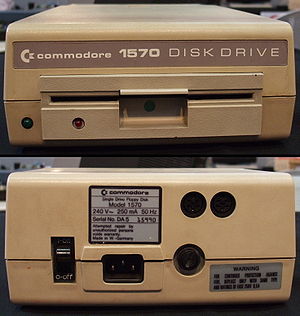
Commodore 1570
Encyclopedia

Floppy disk
A floppy disk is a disk storage medium composed of a disk of thin and flexible magnetic storage medium, sealed in a rectangular plastic carrier lined with fabric that removes dust particles...
drive for the Commodore 128
Commodore 128
The Commodore 128 home/personal computer was the last 8-bit machine commercially released by Commodore Business Machines...
home
Home computer
Home computers were a class of microcomputers entering the market in 1977, and becoming increasingly common during the 1980s. They were marketed to consumers as affordable and accessible computers that, for the first time, were intended for the use of a single nontechnical user...
/personal computer
Personal computer
A personal computer is any general-purpose computer whose size, capabilities, and original sales price make it useful for individuals, and which is intended to be operated directly by an end-user with no intervening computer operator...
. It was a single-sided, 170KB version of the double-sided Commodore 1571
Commodore 1571
The Commodore 1571 was Commodore's high-end 5¼" floppy disk drive. With its double-sided drive mechanism, it had the ability to utilize double-sided, double-density floppy disks natively. This was in contrast to its predecessors, the 1541 and 1570, which could fully utilize such disks only if the...
, released as a stopgap measure when Commodore International
Commodore International
Commodore is the commonly used name for Commodore Business Machines , the U.S.-based home computer manufacturer and electronics manufacturer headquartered in West Chester, Pennsylvania, which also housed Commodore's corporate parent company, Commodore International Limited...
was unable to provide large enough quantities of 1571s due to a shortage of double-sided drive mechanisms. Like the 1571, it could read and write both GCR
Group Code Recording
In computer science, group code recording refers to several distinct but related encoding methods for magnetic media. The first, used in 6250 cpi magnetic tape, is an error-correcting code combined with a run length limited encoding scheme...
and MFM
Modified Frequency Modulation
Modified Frequency Modulation, commonly MFM, is a line coding scheme used to encode the actual data-bits on most floppy disk formats, hardware examples include Amiga, most CP/M machines as well as IBM PC compatibles. Early hard disk drives also used this coding.MFM is a modification to the original...
disk formats.
The 1570 utilized a 1571 logic board in a cream-colored Commodore 1541
Commodore 1541
The Commodore 1541 , made by Commodore International, was the best-known floppy disk drive for the Commodore 64 home computer. The 1541 was a single-sided 170 kilobyte drive for 5¼" disks...
case with a drive mechanism similar to the 1541 except that it was equipped with track zero detection. Like the 1571, its built-in DOS provided a data burst mode for transferring data to the C128 computer at a faster speed than a 1541. Its ROM
Read-only memory
Read-only memory is a class of storage medium used in computers and other electronic devices. Data stored in ROM cannot be modified, or can be modified only slowly or with difficulty, so it is mainly used to distribute firmware .In its strictest sense, ROM refers only...
also contained some DOS bug fixes that didn't appear in the 1571 until much later. The 1570 could read and write all single-sided CP/M format disks that the 1571 could access.
Although the 1570 was compatible with the Commodore 64
Commodore 64
The Commodore 64 is an 8-bit home computer introduced by Commodore International in January 1982.Volume production started in the spring of 1982, with machines being released on to the market in August at a price of US$595...
, the C64 wasn't capable of taking advantage of the drive's higher-speed operation, and when used with the C64 it was little more than a pricier 1541. Also, many early buyers of the C128 chose to temporarily make do with a 1541 drive, perhaps owned as part of a previous C64 setup, until the 1571 became more widely available.

